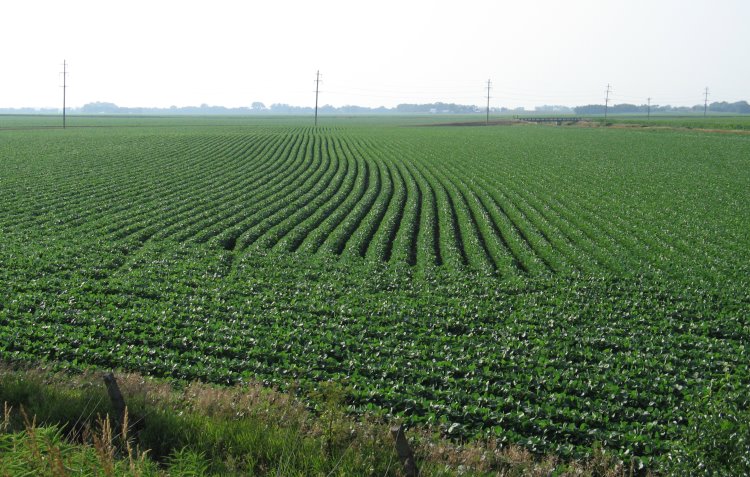Here are 30 facts culled from the 2012 Illinois Land Value report.
1. Both Land Values and Lease Trends continue higher into 2012, and are expected to stay strong as long as crop income levels hold or increase.
2. Price and rent levels both increased steadily through 2011, and consistently among different productivity classes of land and regions of the state.
3. Land values maintain support from investment capital seeking alternatives to other financial assets. Among major issues are interest rates, U.S. and foreign sovereign debt, stock market performance, the dollar value relative to other currencies, and growth of consumer economies around the world.
 4. Long leasehold interests, extended Conservation Reserve Program (CRP) contracts, deed restrictions, etc. that nega- tively impact ownership control penalize land prices.
4. Long leasehold interests, extended Conservation Reserve Program (CRP) contracts, deed restrictions, etc. that nega- tively impact ownership control penalize land prices.
5. As supplies of land tightened buyers were less concerned about one year leases, and receiving partial interests in cur- rent year crop or leases in progress, looking beyond a few months toward long term investment value.
6. The annually renewable USDA Farm Program appears to have very little effect on land values in 2011, eclipsed by other more dominant factors.
7. Current crop genetics increase yields while reducing year-to-year variability, which improves earning potential for lower classes of land.
8. Recreational tracts and transitional development land have been hardest hit because of struggling non-agricultural economies.
9. Some areas or counties carry name or reputation prestige, showing stronger prices than land with similar productivity and attributes in nearby areas or counties. However, undiscovered “pockets of prosperity” where land can be typi- cally purchased at lower prices relative to its productivity are fewer and further between.
10. Regardless of the means of sale – public or sealed bid auction, broker listing, private transactions – excellent and good productivity tracts needed minimal marketing time, with a generally shorter period from exposure-to-market through sale to closing.
11. Not only are farmers the majority of buyers, but adjoining/nearby landowners and current tenants often lead the way.
12. Areas with higher concentrations of livestock – dairy, hogs, poultry – had generally more favorable markets for their production in 2011.
13. Pasture rents have not moved significantly over several years, and can vary widely from $5/ac to more than $60/acre depending on quality or carrying capacity, water source, and contribution to upkeep and maintenance of the land and fences.
14. Variable cash rent leases grow in popularity and pay landowners competitively higher returns in 2011 due to higher average prices and excellent soybean yields.
15. Wind farm activity, where already planned or under construction, continued to impact land values and add to total return in 2011. However changes in tax, policy, and funding have slowed the progress of many wind tower projects.
16. In some areas larger percentage increases for lower productivity land were noted, based on expectations of improv- ing crop returns, and absolute increases on lower values resulting in larger percentage growth.
17. Continuing fixed cash rent rates generally showed a tendency to lag other lease and operating contracts as income returns and commodity markets have been in a general up trend over several successive crop years.
18. By year end 2011 price paid per productivity index (PI) point per acre was running in the upper $60s to mid $70s. One central Illinois region’s data calculated excellent soils averaging $73/PI, good soils $64/PI, and average and fair soils at $60/PI.
19. In many areas of the state it was a challenging crop production year in 2011, with wide variations in conditions from too much rain at times in some locations, to very hot and dry conditions in some areas later in the summer.
20. Calhoun County peaches are seasonally very popular and exceptionally good. (Region 7 slipped in some product- placement advertising.)
21. The generally wet spring throughout the state accentuated the importance of good drainage and much drainage tile and waterway improvement work was done throughout the year. Well-drained or pattern-tiled land will sell for a premium, especially if there are well-documented and accurate maps of drainage improvements.
22. Land value for crop production continues to gain on values for development land, as cropland increases and develop- ment land declines or holds steady.
23. The number of tracts and amount of acres transacted was generally more than previous years, as higher prices pulled supply onto the market.
24. In some local instances proposals for underground gas storage, recent discovery of production volumes of oil, and continuing coal mining has sensitized the market to the value of mineral interests and rights.
25. Irrigated land returned proportionately higher income due to higher commodity prices and improved yield from irrigation.
26. Farm operators continued and expanded the trend of bringing current landlords and other absentee investors to the farmland market.
27. In 2011 there have been several notable expansions or new construction of high capacity grain rail-loading facilities, mostly destined to move Illinois grain to cattle, hog, and poultry operations out of state.
28. Some areas benefit with strong grain prices from grain market outlets on navigable rivers, rail terminals, local area end-users and specialty food product processors.
29. Another year in 2011 where corn following soybeans, rather than one or more years of corn, performed significantly better.
30. Almost every county in the state had instances of a record new high price per acre for farmland.

